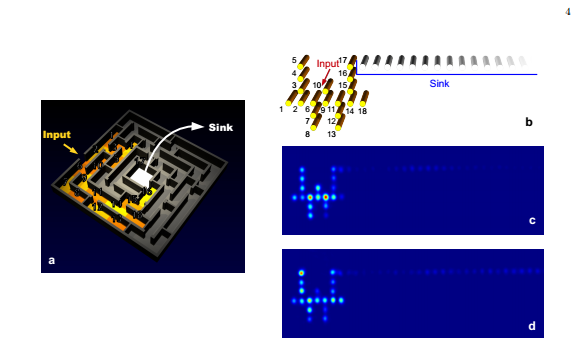Quantum Light Beam Solves Mazes, with a Little Help from Classical Noise
The emerging discipline of quantum biology is attempting to understand the role quantum mechanics plays in the processes of life, such as photosynthesis—the capture of sunlight by plants and its conversion into stored energy.

One phenomenon that physicists have observed is the transfer of energy across giant protein matrices that appears to occur extremely rapidly with close to 100 percent efficiency. These matrices are like giant mazes so the question is how energy can find its way across the structures before it dissipates.
The classical solution to this problem is to explore the maze with a series of random hops. But this process would take so long that most of the energy would be lost.
That’s why physicists think that quantum processes must somehow be involved. Their initial thinking was that the quantum process of energy transfer might work by exploring many routes through the maze at the same time. This superposition of states would then collapse when the solution was found. In this way, the maze can be solved rapidly and the energy transferred efficiently.
But this does not work either. The reason is that a quantum process can interfere with itself and this has the effect of preventing efficient transport across the network.
So the most recent thinking is that the transfer of energy through this maze must rely on both classical and quantum processes. The quantum processes allow several routes to be explored at the same time while the classical processes allow random jumps that prevent the system seizing up due to interference.
Today, Filippo Caruso at the University of Florence in Italy, and a number of pals, say they have demonstrated this effect using light passing through an artificial maze for the first time. Their work provides the first experimental evidence that a hybrid system involving both quantum and classical states significantly outperforms a quantum system alone.
These guys make their maze from a network of waveguides laser machined into a transparent slab. When the waveguides in this array are close together, the light can jump from one to another in a purely quantum process. However, if the waveguides are slightly further apart, the quantum process breaks down, introducing classical noise that forces the system to behave as a hybrid with both quantum and classical properties.
So by creating similar mazes with these subtle differences, Caruso and co can experiment with light travelling in a purely quantum state or in a mixture of quantum and classical states.
And that’s exactly what they’ve done. These guys created 24 mazes with different quantum and classical properties, and set out to discover how efficiently the light could find the exit to the maze in each case.
Their theoretical treatment of this problem gives a clear answer. They calculate that when the quantum and classical states are mixed an optimal way, the transfer efficiency is some five orders of magnitude larger than the purely quantum example.
The results of their experiments back this up. “Our measurements have faithfully confirmed the theoretical predictions,” say Caruso and co. They say the experiments clearly show that classical noise suppresses quantum interference and so enhances the transport dynamics in mazes. However, it is fair to say that the transfer efficiency is nowhere near that achieved in plants. At least not yet.
That’s interesting work because the ability to reproduce, at least partially, the extraordinarily efficient energy transport found in plants could have important applications. “These achievements may lead towards future bio-inspired photonics technologies for more efficient transport and computation,” say Caruso and co. That would include more efficient solar cells and the rapid transmission of information in various kinds of computer.
Given this experimental demonstration, it’ll be interesting to see where physicists attempt to apply it first.
Ref: arxiv.org/abs/1501.06438: Fast Escape from Quantum Mazes in Integrated Photonics
Keep Reading
Most Popular
Large language models can do jaw-dropping things. But nobody knows exactly why.
And that's a problem. Figuring it out is one of the biggest scientific puzzles of our time and a crucial step towards controlling more powerful future models.
The problem with plug-in hybrids? Their drivers.
Plug-in hybrids are often sold as a transition to EVs, but new data from Europe shows we’re still underestimating the emissions they produce.
Google DeepMind’s new generative model makes Super Mario–like games from scratch
Genie learns how to control games by watching hours and hours of video. It could help train next-gen robots too.
How scientists traced a mysterious covid case back to six toilets
When wastewater surveillance turns into a hunt for a single infected individual, the ethics get tricky.
Stay connected
Get the latest updates from
MIT Technology Review
Discover special offers, top stories, upcoming events, and more.